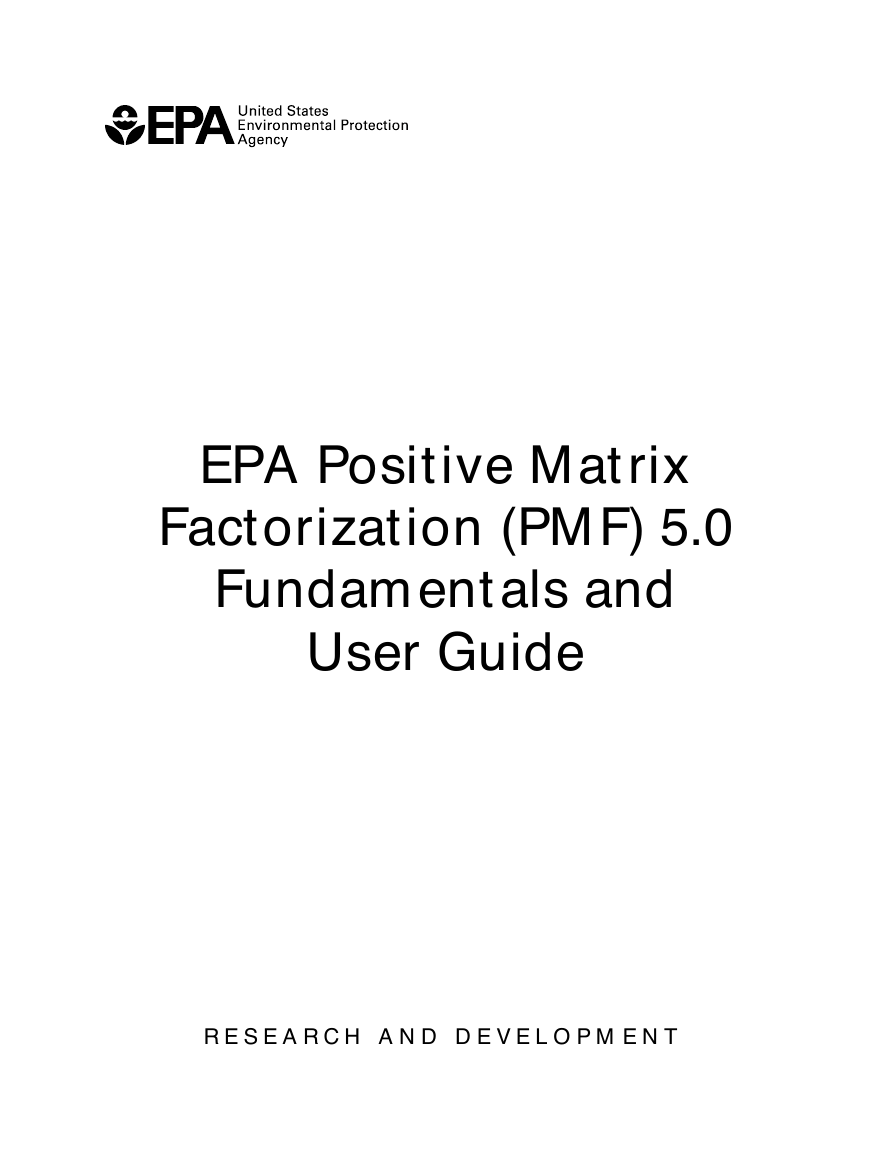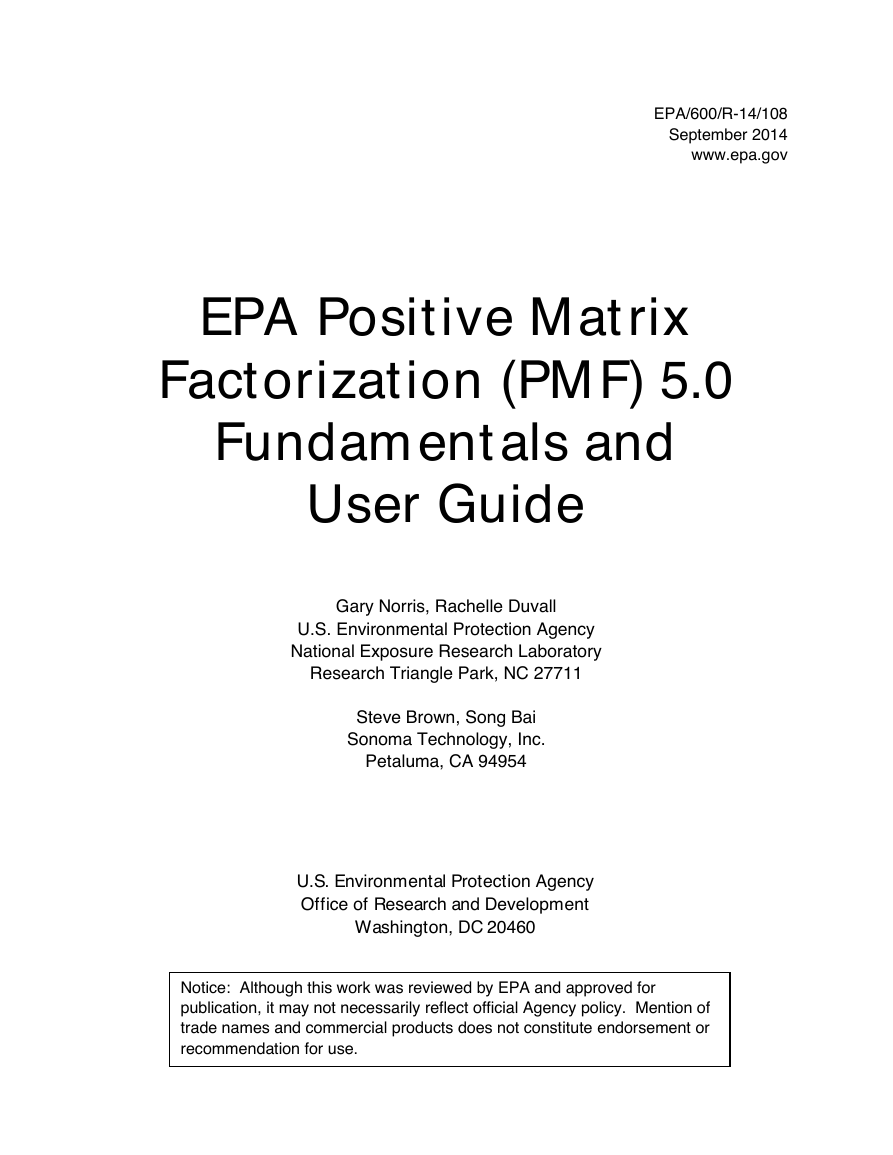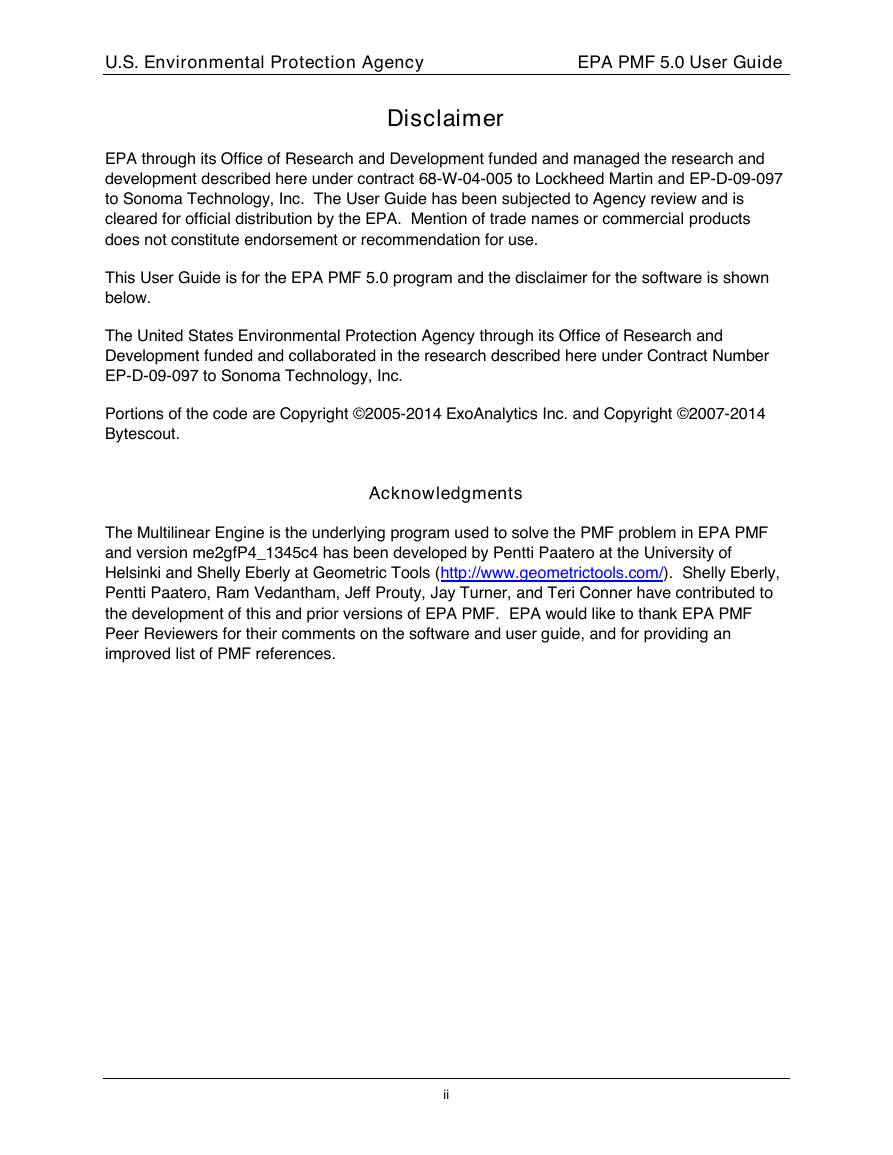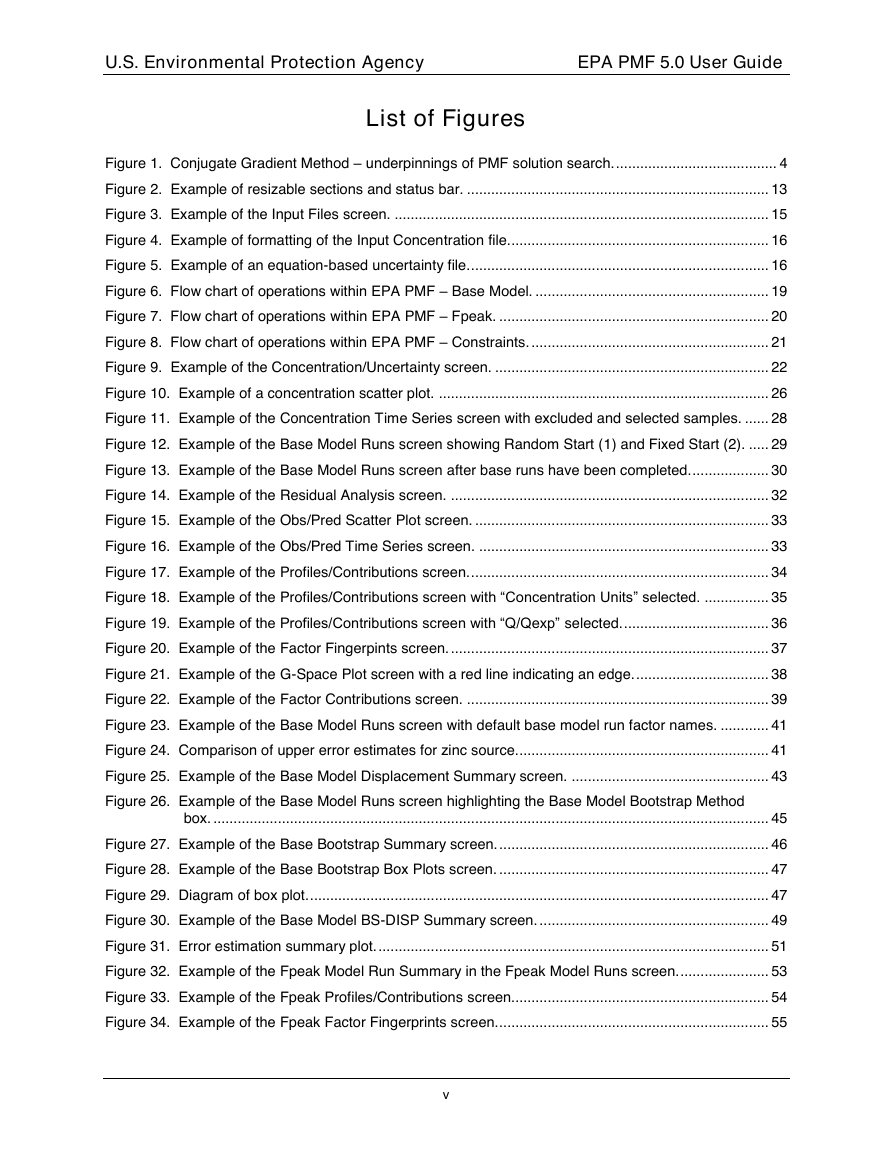EPA Positive M atrix
Factorization (PM F) 5.0
Fundamentals and
User Guide
R E S E A R C H A N D D E V E L O P M E N T
�
�
EPA/600/R-14/108
September 2014
www.epa.gov
EPA Positive M atrix
Factorization (PM F) 5.0
Fundamentals and
User Guide
Gary Norris, Rachelle Duvall
U.S. Environmental Protection Agency
National Exposure Research Laboratory
Research Triangle Park, NC 27711
Steve Brown, Song Bai
Sonoma Technology, Inc.
Petaluma, CA 94954
U.S. Environmental Protection Agency
Office of Research and Development
Washington, DC 20460
Notice: Although this work was reviewed by EPA and approved for
publication, it may not necessarily reflect official Agency policy. Mention of
trade names and commercial products does not constitute endorsement or
recommendation for use.
�
U.S. Environmental Protection Agency
EPA PMF 5.0 User Guide
Disclaimer
EPA through its Office of Research and Development funded and managed the research and
development described here under contract 68-W-04-005 to Lockheed Martin and EP-D-09-097
to Sonoma Technology, Inc. The User Guide has been subjected to Agency review and is
cleared for official distribution by the EPA. Mention of trade names or commercial products
does not constitute endorsement or recommendation for use.
This User Guide is for the EPA PMF 5.0 program and the disclaimer for the software is shown
below.
The United States Environmental Protection Agency through its Office of Research and
Development funded and collaborated in the research described here under Contract Number
EP-D-09-097 to Sonoma Technology, Inc.
Portions of the code are Copyright ©2005-2014 ExoAnalytics Inc. and Copyright ©2007-2014
Bytescout.
Acknowledgments
The Multilinear Engine is the underlying program used to solve the PMF problem in EPA PMF
and version me2gfP4_1345c4 has been developed by Pentti Paatero at the University of
Helsinki and Shelly Eberly at Geometric Tools (http://www.geometrictools.com/). Shelly Eberly,
Pentti Paatero, Ram Vedantham, Jeff Prouty, Jay Turner, and Teri Conner have contributed to
the development of this and prior versions of EPA PMF. EPA would like to thank EPA PMF
Peer Reviewers for their comments on the software and user guide, and for providing an
improved list of PMF references.
ii
�
U.S. Environmental Protection Agency
EPA PMF 5.0 User Guide
Table of Contents
1.
INTRODUCTION ....................................................................................................................... 1
1.1 Model Overview .................................................................................................................. 1
1.2 Multilinear Engine ................................................................................................................ 3
1.3 Comparison to EPA PMF 3.0 and Other Methods .............................................................. 5
2. USES OF PMF .......................................................................................................................... 6
3.
INSTALLING EPA PMF 5.0 .................................................................................................... 11
4. GLOBAL FEATURES ............................................................................................................. 12
5. GETTING STARTED ............................................................................................................... 14
5.1 Input Files .......................................................................................................................... 14
5.2 Output Files ....................................................................................................................... 17
5.3 Configuration Files ............................................................................................................ 18
5.4 Suggested Order of Operations ........................................................................................ 18
5.5 Analyze Input Data ............................................................................................................ 19
5.5.1 Concentration/Uncertainty ................................................................................... 20
5.5.2 Concentration Scatter Plots ................................................................................. 25
5.5.3 Concentration Time Series .................................................................................. 26
5.5.4 Data Exceptions ................................................................................................... 27
5.6 Base Model Runs .............................................................................................................. 27
5.6.1
Initiating a Base Run ............................................................................................ 28
5.6.2 Base Model Run Summary .................................................................................. 29
5.6.3 Base Model Results ............................................................................................. 31
5.6.4 Factor Names on Base Model Runs Screen ....................................................... 40
5.7 Base Model Displacement Error Estimation ..................................................................... 42
5.8 Base Model BS Error Estimation ...................................................................................... 43
5.8.1 Summary of BS Runs........................................................................................... 45
5.8.2 Base Bootstrap Box Plots .................................................................................... 46
5.9 Base Model BS-DISP Error Estimation ............................................................................. 48
5.10 Interpreting Error Estimate Results ................................................................................. 50
6. ROTATIONAL TOOLS ............................................................................................................ 52
6.1 Fpeak Model Run Specification ........................................................................................ 52
6.1.1 Fpeak Results ...................................................................................................... 53
6.1.2 Evaluating Fpeak Results .................................................................................... 57
6.2 Constrained Model Operation ........................................................................................... 58
6.2.1 Constrained Model Run Specification .................................................................. 58
6.2.2 Constrained Profiles/Contribution Results ........................................................... 65
6.2.3 Evaluating Constraints Results ............................................................................ 68
7. TROUBLESHOOTING ............................................................................................................ 70
iii
�
U.S. Environmental Protection Agency
EPA PMF 5.0 User Guide
8. TRAINING EXERCISES .......................................................................................................... 71
8.1 Milwaukee Water Data ...................................................................................................... 72
8.1.1 Data Set Development ......................................................................................... 72
8.1.2 Analyze Input Data ............................................................................................... 73
8.1.3 Base Model Runs ................................................................................................. 73
8.1.4 Error Estimation ................................................................................................... 77
8.2 St. Louis Supersite PM2.5 Data Set ................................................................................... 78
8.2.1 Data Set Development ......................................................................................... 78
8.2.2 Analyze Input Data ............................................................................................... 81
8.2.3 Base Model Runs ................................................................................................. 83
8.2.4 Error Estimation ................................................................................................... 85
8.2.5 Constrained Model Runs ..................................................................................... 85
8.3 Baton Rouge PAMS VOC Data Set .................................................................................. 87
8.3.1 Data Set Development ......................................................................................... 90
8.3.2 Analyze Input Data ............................................................................................... 91
8.3.3 Base Model Runs ................................................................................................. 93
8.3.4 Base Model Run Results ..................................................................................... 94
8.3.5 Fpeak ................................................................................................................. 100
8.3.6 Constrained Model Runs ................................................................................... 103
9. PMF & APPLICATION REFERENCES ................................................................................ 105
iv
�
U.S. Environmental Protection Agency
EPA PMF 5.0 User Guide
List of Figures
Figure 1. Conjugate Gradient Method – underpinnings of PMF solution search. ........................................ 4
Figure 2. Example of resizable sections and status bar. ........................................................................... 13
Figure 3. Example of the Input Files screen. ............................................................................................. 15
Figure 4. Example of formatting of the Input Concentration file................................................................. 16
Figure 5. Example of an equation-based uncertainty file. .......................................................................... 16
Figure 6. Flow chart of operations within EPA PMF – Base Model. .......................................................... 19
Figure 7. Flow chart of operations within EPA PMF – Fpeak. ................................................................... 20
Figure 8. Flow chart of operations within EPA PMF – Constraints. ........................................................... 21
Figure 9. Example of the Concentration/Uncertainty screen. .................................................................... 22
Figure 10. Example of a concentration scatter plot. .................................................................................. 26
Figure 11. Example of the Concentration Time Series screen with excluded and selected samples. ...... 28
Figure 12. Example of the Base Model Runs screen showing Random Start (1) and Fixed Start (2). ..... 29
Figure 13. Example of the Base Model Runs screen after base runs have been completed. ................... 30
Figure 14. Example of the Residual Analysis screen. ............................................................................... 32
Figure 15. Example of the Obs/Pred Scatter Plot screen. ......................................................................... 33
Figure 16. Example of the Obs/Pred Time Series screen. ........................................................................ 33
Figure 17. Example of the Profiles/Contributions screen. .......................................................................... 34
Figure 18. Example of the Profiles/Contributions screen with “Concentration Units” selected. ................ 35
Figure 19. Example of the Profiles/Contributions screen with “Q/Qexp” selected. .................................... 36
Figure 20. Example of the Factor Fingerpints screen. ............................................................................... 37
Figure 21. Example of the G-Space Plot screen with a red line indicating an edge. ................................. 38
Figure 22. Example of the Factor Contributions screen. ........................................................................... 39
Figure 23. Example of the Base Model Runs screen with default base model run factor names. ............ 41
Figure 24. Comparison of upper error estimates for zinc source............................................................... 41
Figure 25. Example of the Base Model Displacement Summary screen. ................................................. 43
Figure 26. Example of the Base Model Runs screen highlighting the Base Model Bootstrap Method
box. .......................................................................................................................................... 45
Figure 27. Example of the Base Bootstrap Summary screen. ................................................................... 46
Figure 28. Example of the Base Bootstrap Box Plots screen. ................................................................... 47
Figure 29. Diagram of box plot. .................................................................................................................. 47
Figure 30. Example of the Base Model BS-DISP Summary screen. ......................................................... 49
Figure 31. Error estimation summary plot. ................................................................................................. 51
Figure 32. Example of the Fpeak Model Run Summary in the Fpeak Model Runs screen. ...................... 53
Figure 33. Example of the Fpeak Profiles/Contributions screen................................................................ 54
Figure 34. Example of the Fpeak Factor Fingerprints screen.................................................................... 55
v
�
U.S. Environmental Protection Agency
EPA PMF 5.0 User Guide
Figure 35. Example of the Fpeak G-Space Plot screen. ........................................................................... 56
Figure 36. Example of the Fpeak Factor Contributions screen. ................................................................ 57
Figure 37. G-Space plot and delta between the base run contribution and Fpeak run contribution
for each contribution point. ...................................................................................................... 58
Figure 38. Expression Builder – Ratio. ...................................................................................................... 60
Figure 39. Expression Builder – Mass Balance. ........................................................................................ 60
Figure 40. Expression Builder – Custom. .................................................................................................. 61
Figure 41. Example of expressions on the Constrained Model Runs screen. ........................................... 61
Figure 42. Selecting constrained species and observations. ..................................................................... 62
Figure 43. Example of selecting points to pull to the y-axis in the G-space plot. ...................................... 63
Figure 44. Example of the Constrained Model Run summary table. ......................................................... 64
Figure 45. Example of the Constrained Profiles/Contributions screen. ..................................................... 65
Figure 46. Example of the Constrained Factor Fingerprints screen. ......................................................... 66
Figure 47. Example of the Constrained G-Space Plot screen. .................................................................. 67
Figure 48. Example of the Constrained Factor Contributions screen. ....................................................... 68
Figure 49. Example of the Constrained Diagnostics screen. ..................................................................... 69
Figure 50. PMF results evaluation process. ............................................................................................... 71
Figure 51. Deep tunnel system. ................................................................................................................. 73
Figure 52. Scatter plot of BOD5 and TSS. ................................................................................................. 74
Figure 53. Example of observed/predicted results for cadmium................................................................ 74
Figure 54. Stacked Graph plot. .................................................................................................................. 75
Figure 55. Profiles/Contributions Plot for mulitiple site data. ..................................................................... 76
Figure 56. Observed/Predicted Time Series Plot for multiple site data. .................................................... 77
Figure 57. Comparison of error estimation results. .................................................................................... 78
Figure 58. Error estimation summary plot of range of concentration by species in each factor. ............... 79
Figure 59. Satellite image of St. Louis Supersite and major emissions sources. ...................................... 80
Figure 60. Concentration Time Series screen and zoomed-in diagram for the St. Louis data set. ........... 81
Figure 61. Concentration scatter plots for steel elements. ........................................................................ 82
Figure 62. Example of output graphs for cadmium (poorly modeled) and lead (well-modeled). ............... 83
Figure 63. Example of inconsistencies in input data. The multiple points shown in blue in the lower
left graphic are fixed values. .................................................................................................... 84
Figure 64. Example of G-space plots for independent (left) and weakly dependent factors (right). .......... 85
Figure 65. St. Louis stacked base factor profiles. ...................................................................................... 86
Figure 66. Distribution of mass for St. Louis PM2.5. ................................................................................... 87
Figure 67. Summary of base run and error estimates. .............................................................................. 88
Figure 68. Comparison of base model and constrained model run profiles for the steel factor. ............... 88
Figure 69. Summary of constrained run and error estimates. ................................................................... 90
Figure 70. Relationships between ambient concentrations of various species. ........................................ 92
vi
�
















 2023年江西萍乡中考道德与法治真题及答案.doc
2023年江西萍乡中考道德与法治真题及答案.doc 2012年重庆南川中考生物真题及答案.doc
2012年重庆南川中考生物真题及答案.doc 2013年江西师范大学地理学综合及文艺理论基础考研真题.doc
2013年江西师范大学地理学综合及文艺理论基础考研真题.doc 2020年四川甘孜小升初语文真题及答案I卷.doc
2020年四川甘孜小升初语文真题及答案I卷.doc 2020年注册岩土工程师专业基础考试真题及答案.doc
2020年注册岩土工程师专业基础考试真题及答案.doc 2023-2024学年福建省厦门市九年级上学期数学月考试题及答案.doc
2023-2024学年福建省厦门市九年级上学期数学月考试题及答案.doc 2021-2022学年辽宁省沈阳市大东区九年级上学期语文期末试题及答案.doc
2021-2022学年辽宁省沈阳市大东区九年级上学期语文期末试题及答案.doc 2022-2023学年北京东城区初三第一学期物理期末试卷及答案.doc
2022-2023学年北京东城区初三第一学期物理期末试卷及答案.doc 2018上半年江西教师资格初中地理学科知识与教学能力真题及答案.doc
2018上半年江西教师资格初中地理学科知识与教学能力真题及答案.doc 2012年河北国家公务员申论考试真题及答案-省级.doc
2012年河北国家公务员申论考试真题及答案-省级.doc 2020-2021学年江苏省扬州市江都区邵樊片九年级上学期数学第一次质量检测试题及答案.doc
2020-2021学年江苏省扬州市江都区邵樊片九年级上学期数学第一次质量检测试题及答案.doc 2022下半年黑龙江教师资格证中学综合素质真题及答案.doc
2022下半年黑龙江教师资格证中学综合素质真题及答案.doc